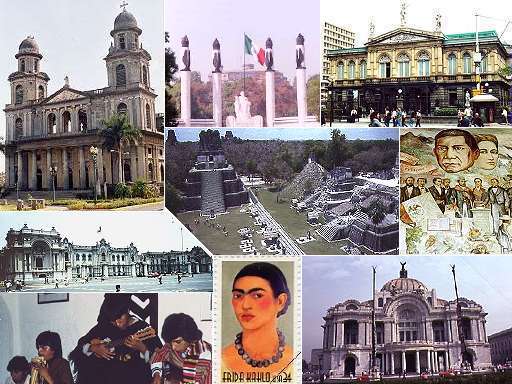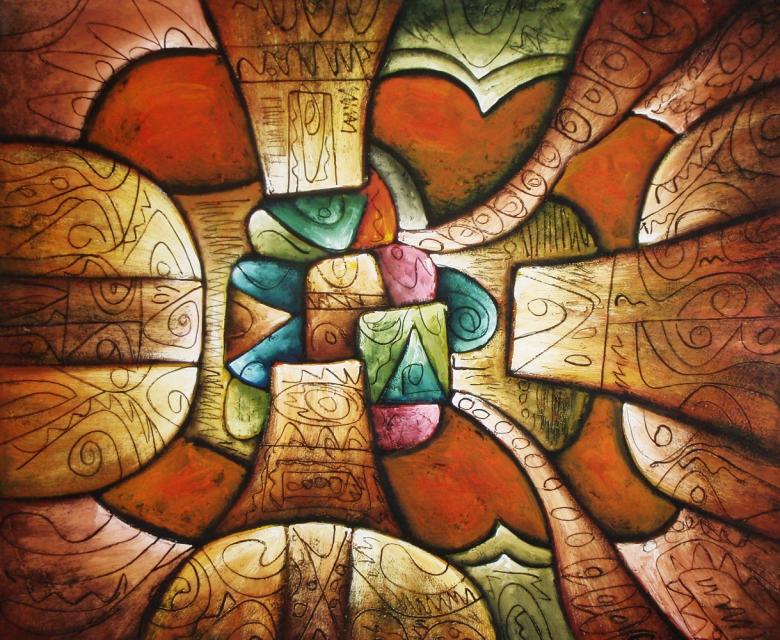Latin American culture is a mixture of many cultural expressions worldwide. It is the product of many diverse influences:
- Indigenous cultures of the people who inhabited the continent prior to the arrival of the Europeans. Ancient and very advanced civilizations developed their own political, social and religious systems. The Maya , the Aztecs and the Incas are examples of these.
- Western civilization , in particular the culture of Europe , was brought mainly by the colonial powers—the Spanish , Portuguese and French —between the 16th and 19th centuries. The most enduring European colonial influence is language and Roman Catholicism . More recently, additional cultural influences came from the United States and Europe during the nineteenth and twentieth centuries, due to the growing influence of the former on the world stage and immigration from the later. The influence of the United States is particularly strong in northern Latin America, especially Puerto Rico, which is a United States territory. In addition, the United States held the twenty-mile-long Panama Canal Zone in Panama from 1903 (the Panama Canal opened to transoceanic freight traffic in 1914) to 1999, when the Torrijos-Carter Treaties restored Panamanian control of the Canal Zone. South America experienced waves of immigration of Europeans, especially Italians , Spaniards , Portuguese , and Germans . With the end of colonialism, French culture was also able to exert a direct influence in Latin America, especially in the realms of high culture , science and medicine . This can be seen in any expression of the region's artistic traditions, including painting, literature and music, and in the realms of science and politics.
- African cultures , whose presence derives from a long history of New World slavery . Peoples of African descent have influenced the ethno-scapes of Latin America and the Caribbean. This is manifested for instance in dance and religion, especially in countries like Belize , Brazil, Honduras, Puerto Rico, Venezuela, Colombia, Panama, Haiti, Costa Rica, Dominican Republic, and Cuba.
Art
Beyond the rich tradition of indigenous art, the development of Latin American visual art owed much to the influence of Spanish, Portuguese and French Baroque painting, which in turn often followed the trends of the Italian Masters. In general, this artistic Eurocentrism began to fade in the early twentieth century, as Latin-Americans began to acknowledge the uniqueness of their condition and started to follow their own path.
From the early twentieth century, the art of Latin America was greatly inspired by the Constructivist Movement. The Constructivist Movement was founded in Russia around 1913 by Vladimir Tatlin . The Movement quickly spread from Russia to Europe and then into Latin America. Joaquin Torres Garcia and Manuel Rendón have been credited with bringing the Constructivist Movement into Latin America from Europe.
An important artistic movement generated in Latin America is muralism represented by Diego Rivera , David Alfaro Siqueiros , José Clemente Orozco and Rufino Tamayo in Mexico and Santiago Martinez Delgado and Pedro Nel Gómez in Colombia. Some of the most impressive Muralista works can be found in Mexico , Colombia , New York City , San Francisco , Los Angeles and Philadelphia .
Painter Frida Kahlo , one of the most famous Mexican artists, painted about her own life and the Mexican culture in a style combining Realism , Symbolism and Surrealism . Kahlo's work commands the highest selling price of all Latin American paintings.
Colombian sculptor and painter Fernando Botero is also widely known by his works which, on first examination, are noted for their exaggerated proportions and the corpulence of the human and animal figures.
Literature
.Pre-Columbian cultures were primarily oral, though the Aztecs and Mayans, for instance, produced elaborate codices . Oral accounts of mythological and religious beliefs were also sometimes recorded after the arrival of European colonizers, as was the case with the Popol Vuh . Moreover, a tradition of oral narrative survives to this day, for instance among the Quechua -speaking population of Peru and the Quiché (K'iche') of Guatemala.
From the very moment of Europe's "discovery" of the continent, early explorers and conquistadores produced written accounts and crónicas of their experience—such as Columbus 's letters or Bernal Díaz del Castillo 's description of the conquest of Mexico. During the colonial period, written culture was often in the hands of the church, within which context Sor Juana Inés de la Cruz wrote memorable poetry and philosophical essays. Towards the end of the 18th Century and the beginning of the 19th, a distinctive criollo literary tradition emerged, including the first novels such as Lizardi's El Periquillo Sarniento (1816).
The 19th century was a period of "foundational fictions" (in critic Doris Sommer's words), novels in the Romantic or Naturalist traditions that attempted to establish a sense of national identity, and which often focussed on the indigenous question or the dichotomy of "civilization or barbarism" (for which see, say, Domingo Sarmiento 's Facundo (1845), Juan León Mera 's Cumandá (1879), or Euclides da Cunha 's Os Sertões (1902). The 19th century also witnessed the realist work of Machado de Assis , who made use of surreal devices of metaphor and playful narrative construction, much admired by critic Harold Bloom .
At the turn of the 20th century, modernismo emerged, a poetic movement whose founding text was Nicaraguan poet Rubén Darío 's Azul (1888). This was the first Latin American literary movement to influence literary culture outside of the region, and was also the first truly Latin American literature, in that national differences were no longer so much at issue. José Martí , for instance, though a Cuban patriot, also lived in Mexico and the U.S. and wrote for journals in Argentina and elsewhere.
However, what really put Latin American literature on the global map was no doubt the literary boom of the 1960s and 1970s, distinguished by daring and experimental novels (such as Julio Cortázar 's Rayuela (1963)) that were frequently published in Spain and quickly translated into English. The Boom's defining novel was Gabriel García Márquez 's Cien años de soledad (1967), which led to the association of Latin American literature with magic realism , though other important writers of the period such as the Peruvian Mario Vargas Llosa and Carlos Fuentes do not fit so easily within this framework. Arguably, the Boom's culmination was Augusto Roa Bastos 's monumental Yo, el supremo (1974). In the wake of the Boom, influential precursors such as Juan Rulfo , Alejo Carpentier , and above all Jorge Luis Borges were also rediscovered.
Music and dance
Latin America has produced many successful worldwide artists in terms of recorded global music sales. The most successful have been Roberto Carlos who has sold over 100 million records, Carlos Santana with over 75 million, Luis Miguel , Shakira and Vicente Fernandez with over 50 million records sold worldwide. One of the main characteristics of Latin American music is its diversity, from the lively rhythms of Central America and the Caribbean to the more austere sounds of the Andes and the Southern Cone . Another feature of Latin American music is its original blending of the variety of styles that arrived in The Americas and became influential, from the early Spanish and European Baroque to the different beats of the African rhythms.
Caribbean Hispanic music, such as merengue , bachata , salsa , and more recently reggaeton , from such countries as the Dominican Republic, Puerto Rico,Trinidad, Cuba, and Panama has been strongly influenced by African rhythms and melodies. Haiti's compas is a genre of music that draws influence and is thus similar to its Caribbean Hispanic counterparts, with an element of jazz and modern sound as well.
Another well-known Latin American musical genre includes the Argentine and Uruguayan tango , as well as the distinct nuevo tango , a fusion of tango, acoustic and electronic music popularized by bandoneón virtuoso Ástor Piazzolla . Equally renown, the samba , North American jazz , European classical music and choro combined to form bossa nova in Brazil, popularized by guitarrist João Gilberto and pianist Antonio Carlos Jobim .
More recently, Reggaeton , which blends Jamaican reggae and dancehall with Latin America genres such as bomba and plena , as well as that of hip hop , is becoming more popular, in spite of the controversy surrounding its lyrics, dance steps ( Perreo ) and music videos. It has become very popular among populations with a "migrant culture" influence – both Latino populations in the U.S., such as southern Florida and New York City, and parts of Latin America where migration to the U.S. is common, such as Puerto Rico, Trinidad, Dominican Republic, Colombia, Ecuador, El Salvador, and Mexico.






